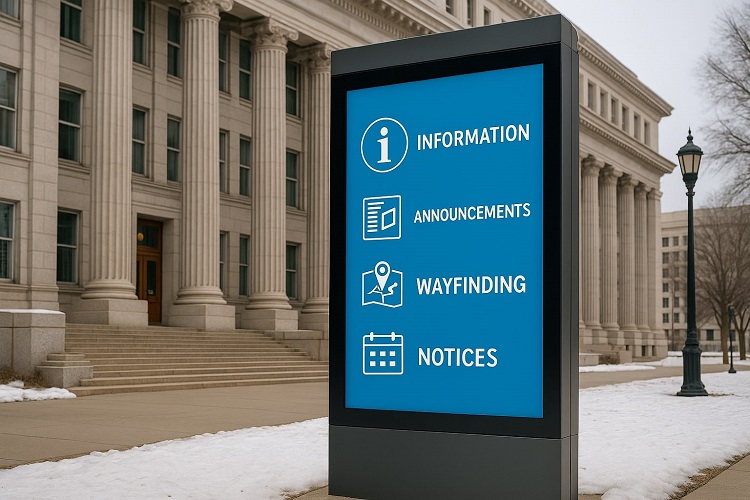In an era where digital technology pervades every aspect of life, public sector institutions are also evolving to incorporate digital solutions into their operations. A significant leap forward in this digital transformation is the utilisation of government digital signage. This technology is not just about replacing the old cork bulletin boards; it’s redefining how public services communicate with citizens and enhancing operational efficiency within government departments.
Table of Contents
Increasing Engagement with Digital Signage
The most immediate advantage of digital signage is its power to engage. Dynamic displays replace static posters and announcements, capturing attention through moving images, videos, and interactive content. For governments, this means the ability to convey critical information in a way that is both accessible and compelling to a wide audience.
An informed citizenry is a cornerstone of democracy, and government digital signage plays a critical role in this by making information readily available. From public health announcements to emergency alerts and community events, digital signs can disseminate vital information quickly and reliably.
Streamlining Operations with Digital Technology
Efficiency within government services is paramount, and digital signage contributes to streamlining operations. By reducing the reliance on printed materials, government entities can save on resources and update information rapidly without the logistical challenges posed by traditional means. This immediate update capability is crucial in situations that demand timely announcements, such as changes in legislation or public transport schedules.
Beyond this, digital signage can act as a navigational guide within public buildings, helping visitors find their way around government offices and facilities. This reduces staff burden by minimising the need for direction and assistance, allowing them to focus on more important tasks.
The Role of Digital Signage in Service Accessibility
Accessibility is a key tenet for public services, and government digital signage addresses this through customisation options. Digital displays can adapt to provide larger texts for visibility, incorporate sign language for deaf communities, and support multiple languages for diverse populations. With government institutions serving an array of individuals with different needs, digital signage provides a flexible platform to cater to this diversity.
Moreover, digital signage has the ability to integrate with other technologies, including voice-assisted services and mobile connectivity, to further enhance accessibility for individuals with disabilities or those who prefer digital communication channels.
Cost-Effectiveness of Digital Signage Solutions
Another aspect where digital signage is transformative for government services is in its cost-effectiveness. Once implemented, the cost of updating digital content is significantly lower than reprinting and redistributing traditional materials. This is particularly important for government bodies that must adhere to strict budget constraints.
The long-term savings associated with digital signage are not to be underestimated. Besides reduced printing costs, digital solutions are energy-efficient with lower power consumption and maintenance requirements than one might expect, especially when compared to old-fashioned neon or fluorescent signs.
Broader Applications of Digital Signage
The utility of digital signage extends beyond government institutions, with other sectors reaping its benefits. For instance, restaurant signage leverages digital displays to showcase menus, special offers, and events to enhance the customer experience and increase sales. The flexibility and immediacy of digital signage in such environments help businesses adapt to frequent changes and customer preferences.
Furthermore, the integration of digital signage into education, healthcare, and corporate environments illustrates its versatility and the value it provides in facilitating communication and operations across varying industries.
Adoption Challenges and Considerations
Despite its many advantages, the adoption of government digital signage can face challenges. Budget constraints, technological literacy among staff, and concerns over cybersecurity are pertinent issues governments must address. Ensuring that both hardware and software components adhere to stringent security standards is critical to mitigate risks associated with digital systems.
Additionally, there is a need for strategic planning in terms of content management and system updates. The effectiveness of digital signage depends on timely and relevant content, which necessitates ongoing content creation and curation efforts.
Looking to the Future
As digital signage technology continues to advance, its potential applications within public services are bound to expand. Artificial intelligence (AI) and machine learning can be harnessed to personalise information dissemination and improve predictive analyses for public safety announcements.
For government entities looking to embrace digital signage, companies such as Just Digital Signage offer end-to-end solutions tailored to the specific needs of public sector institutions. With expertise in delivering impactful signage solutions, they are key partners in the digitalisation of public services.
Conclusion
Government digital signage is more than just a communication tool; it is a strategic asset that transforms the provision of public services. By improving engagement, streamlining operations, enhancing accessibility, and cutting costs, digital signage is frontlining a digital revolution in how governments interact with citizens. As the public sector seeks to modernise and innovate, digital signage stands out as a beacon of progress and efficiency in serving the common good.
The integration of digital technologies like signage is indicative of a broader shift towards a more connected, dynamic, and responsive public service, further highlighting the transformative impact of digital innovations in the pursuit of better governance and public wellbeing.

